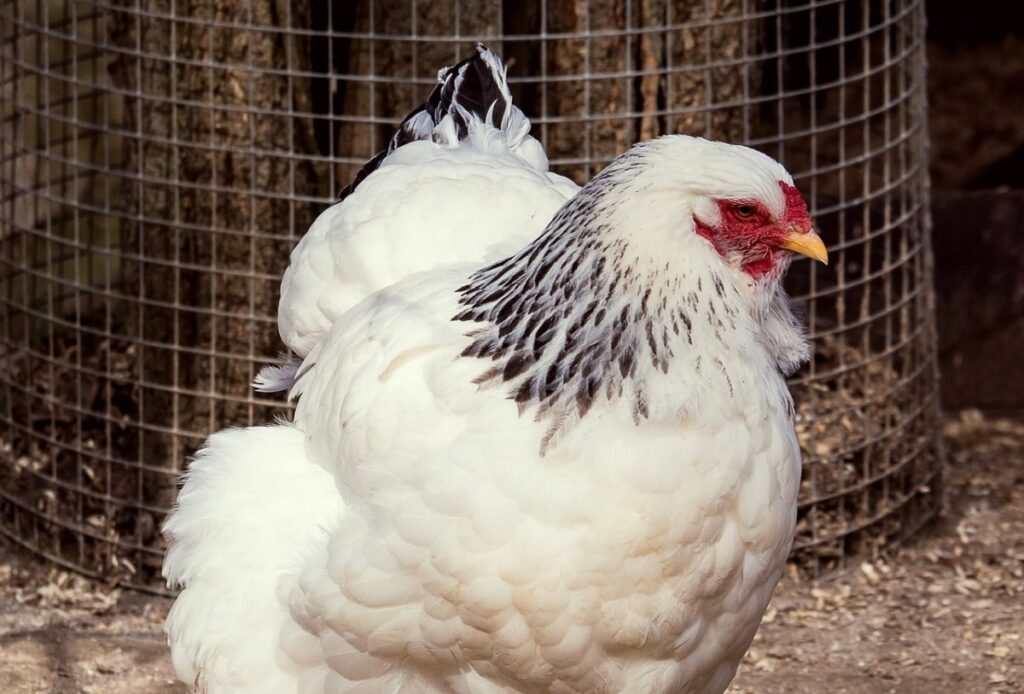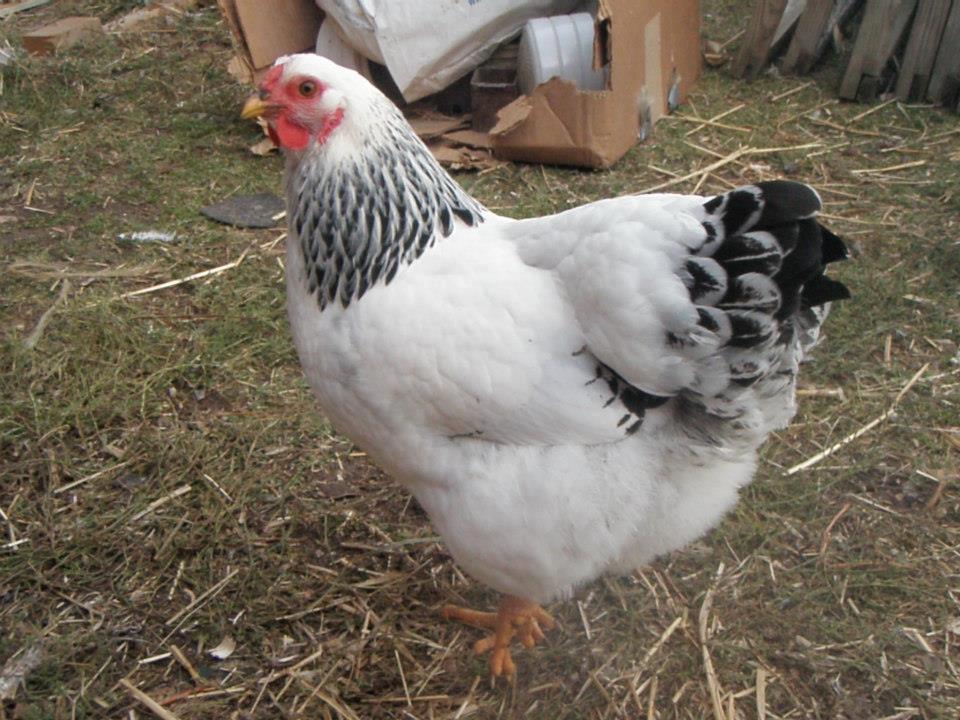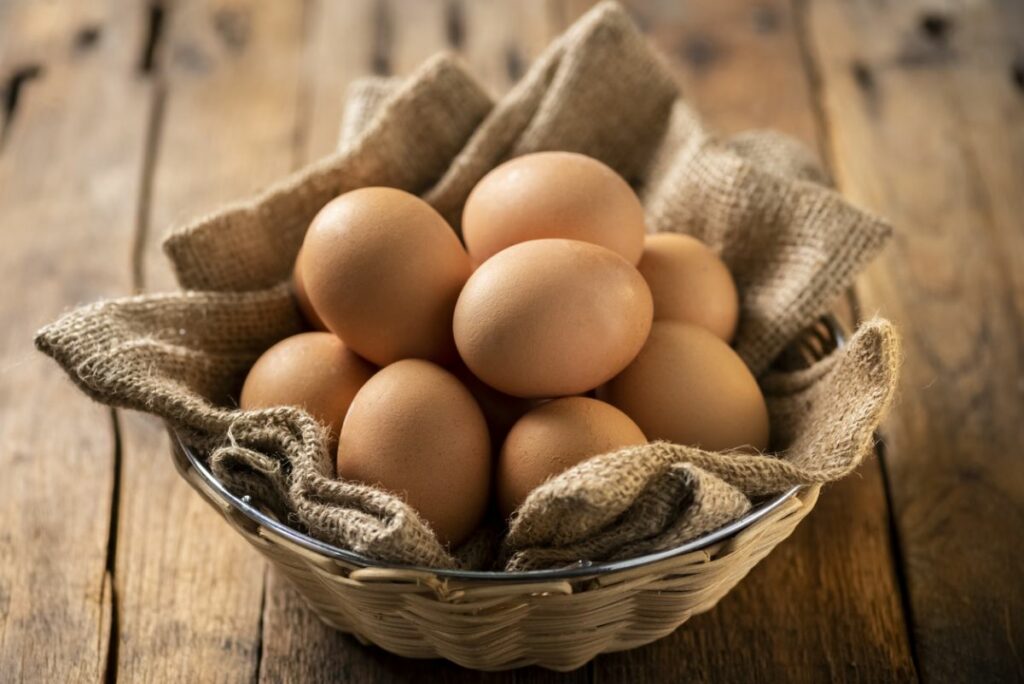The Columbian Wyandotte chicken is a beautiful color variety of the Wyandotte species. They’re a great beginner bird due to their docile temperament and easy care.
So, how do you care for this unique breed, and is it the right chicken species for you?
Columbian Wyandotte Overview

Before we learn about this bird’s appearance, temperament, and care, here’s a quick overview of what to expect.
| Lifespan | 5 to 12 years |
| Weight | 6 to 9 pounds |
| Appearance | Solid white with collar of dark feathers |
| Egg Production | 4 eggs weekly, 200 annually |
| Egg Color | Brown |
| Good for Beginners? | Yes |
| Minimum Coop Size | 6 square feet per bird |
| Price | $3 to $20 per chick |
History
Back in the 1800s, there were very few dual purpose chicken breeds. So, in the 1870s, chicken keepers bred the first Wyandotte chicken, which was meant to be great for both meat and egg production. Its large body and thick feathers were also designed to help it withstand northern winters.
Like many chicken breeds, Wyandottes started as a mix between other chickens. While the exact combination isn’t known, it’s suspected that Brahmas and Hamburgs played a part in the breed’s inception.
To this day, the breed remains popular for farmers in northern states. These popular chickens are great for both eggs and/or meat.
Appearance
Wyandottes can have a wide range of appearances, but this variant is one of the most unique. So, let’s see how this chickens look depending on their sex and life stage.
Columbian Wyandotte Eggs
The Columbian Wyandotte egg color is usually a light brown color but may also have a pink tone at times. In some cases, the eggs could even be described as a rich brown that looks like the color of hot chocolate. These birds always lay medium-sized eggs.
Columbian Wyandotte Pullet
A “pullet” is like the teenage equivalent of a chicken. It’s the stage between a chick and an adult. Most pullets have an awkward appearance since their feathers haven’t fully come in yet.
A Columbian Wyandotte chick looks like your typical chick with fuzzy yellow and black feathers. Yet, as the young birds grow into pullets, their new feathers end up being mostly white. The darker feathers don’t usually grow in until the pullets become adults.
Columbian Wyandotte Hen
This color variant is almost all white except for a ring of black feathers around the neck, which looks like a collar or necklace. The feathers near their wing tips and tails may also be black. They have round bodies and fluffy feathers to protect them from cold weather.
These hens also have a rose comb that rests close to their heads to protect them from frostbite. Wyandotte hens usually weight between six and seven pounds.
Columbian Wyandotte Rooster

Wyandotte roosters are a bit larger, weighing between eight and nine pounds. This color variety is similar to the hens since they both have a white body and black “collar.” However, the black tail is more prominent on the rooster due to its “V-shaped” body.
Personality
Wyandottes are excellent chickens for new owners because they have an easy-going temperament. They’re usually calm and friendly, but they’re also very curious. They love to explore new areas, which can get them into trouble if they’re not confined at all. A large enclosure is a great way to satisfy their needs while still keeping them safe.
Broodiness
These hens aren’t known to be broody, but it’s possible. If the weather and living conditions are ideal, hens can be great mothers to their chicks. Yet, their broodiness isn’t overwhelming.
Are They Loud?
In general, Wyandottes aren’t noisy birds, but hens can be when laying eggs. Egg-laying hens love to chatter amongst each other, which is a normal chicken behavior. While there are ways to make chickens quieter, chicken sounds are a natural part of their behaviors, so it can’t be deterred completely.
Do They Get Along with Other Animals?
This chicken breed usually gets along with different types of birds. They’re unlikely to pick fights with other animals, which is another reason why they’re great for beginners. However, their curiosity makes them an easy target for predators, so keep them secure from animals that could hurt them.
Care Requirements

If you’re interested in keeping these beautiful birds, you’ll need to know how to care for them. Here are some tips for how to keep a Columbian Wyandotte happy and healthy!
Feeding
Chicks have a lot of growing to do, so they need to start with a feed that has a lot of protein. A chicken starter with at least 20% protein is ideal. Then, once your chicks are around 16 to 20 weeks old, you can gradually switch them to a feed with less protein. A 16% layer feed is typical for adult hens.
Hens also need added calcium in their diets. You can provide them oyster shells in a separate food container to give them added calcium. Giving oysters to your hens will make the eggs they produce healthier. Birds who are molting can benefit from a higher protein chicken feed.
Wyandottes can also gather healthy nutrients while foraging for food. Even chickens that get plenty of feed will still pick up plants, bugs, and others items that they find. Foraging is an essential part of a chicken diet, and it’s a great way for them to get extra nutrients.
No matter what chicken breed you care for, they should have clean water accessible to them at all times. Replace the water whenever it has dirt and debris in it to ensure that your birds stay healthy.
Housing
Wyandottes are big birds, so they need plenty of space. Four to six square feet of coop space is the minimum, but it can’t hurt to give them a little extra room just to be safe. Each chicken should also get eight to ten inches of roost space inside the coop.
During summer months, hens will want a lot of space to spread out from each other, but in warm months, they’ll huddle together to keep warm. Their nesting boxes should be 12 inches by 12 inches.
Columbian Wyandottes love having free range time. Yet, they’re not good at escaping predators, so a good alternative is to have their outdoor space in a large fenced-in area. These birds can’t fly well, so the fence doesn’t have to be very tall to keep them safe.
If these birds don’t have enough space inside or outside, they may pick up bad habits. Hens who become bored may pick at each other’s feathers. So, it’s better to have too much space than too little.
Temperature
Wyandottes can withstand cold weather much better than the average chicken. Their thick feathers and rose comb make them less likely to suffer from frost bite. They can tolerate all types of weather, but they’re much more suitable for areas with cold seasons than places that are warm year-round.
Health Concerns
These birds are strong and healthy, so they’re not prone to any major diseases. However, many chicken keepers still get their Wyandottes vaccinated at a young age just to be safe.
Like all chickens, Wyandottes can suffer from mites, lice, and worms. These pests can easily be prevented if you keep their coop clean and take your birds in for vet checkups. However, if they get infested, they can easily be cured with medications.
The only reason your birds might be overly unhealthy is if you buy them from an inhumane breeder. Unique colors of Wyandottes are in high demand, so some breeders will focus on the colors more than the health of the bird. When buying a Columbian color variant, make sure they still have a standard body type that can protect them from the cold.
Columbian Wyandotte Egg Production

Most Wyandottes lay between three and four eggs per week. Since they can lay eggs even during winter months, you’ll end up with 200 to 250 eggs annually. They might not produce as many eggs as other popular breeds, but their egg-laying schedule is consistent.
Frequently Asked Questions
Before you decide if a Wyandotte is the right chicken for you, there might be some lingering questions you want to ask. So, here are some things that new chicken keepers commonly wonder.
Delaware chickens look similar to Columbian Wyandottes. However, a Delaware’s black “collar” isn’t as distinguished. Both chickens have a similar temperament and egg-laying abilities, so either breed can be a good match for beginners.
The US Poultry Association recognizes 19 Wyandotte varieties, including 9 standards and 10 bantams. Columbian is one of the recognized Wyandottes.
Is a Columbian Wyandotte Right for You?
The Columbian Wyandotte chicken breed is beautiful, which is why they’re one of the most desired Wyandotte varieties. However, you should never buy an animal only for its appearance. Instead, you should make sure you can handle its temperament and care requirements too.
Luckily, Wyandottes are calm chickens that are great for beginners. They can be used for a variety of purposes, especially egg production and meat. So, if you’re looking for an easy, gorgeous chicken breed, then these birds might be perfect for your flock.
